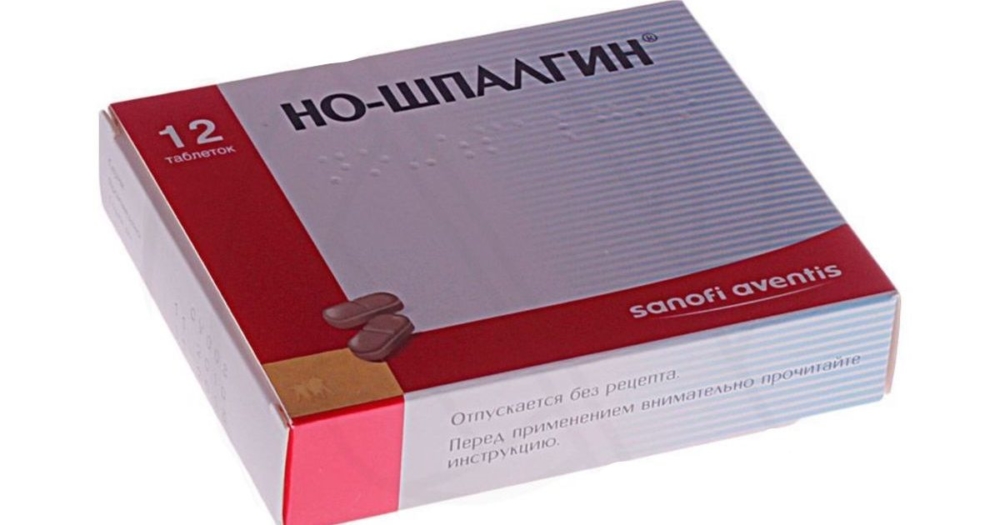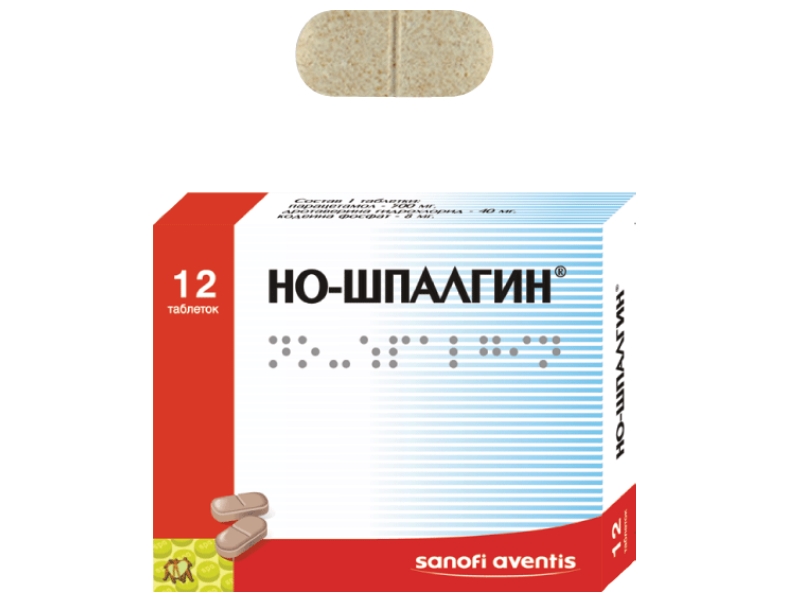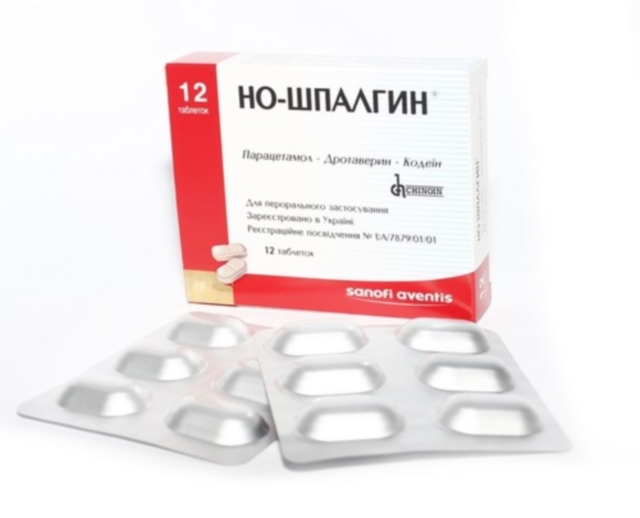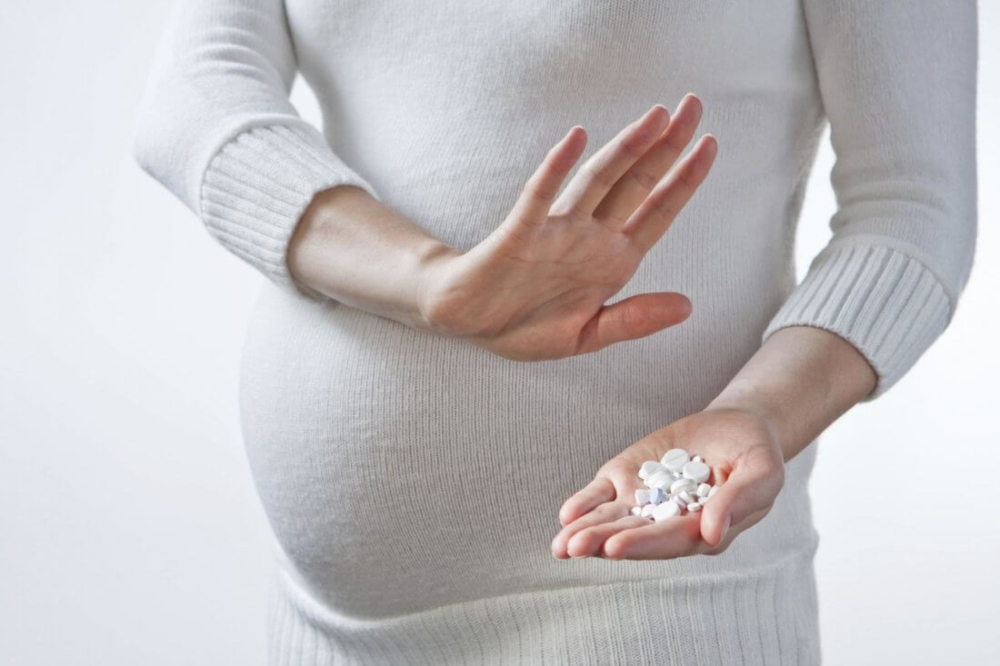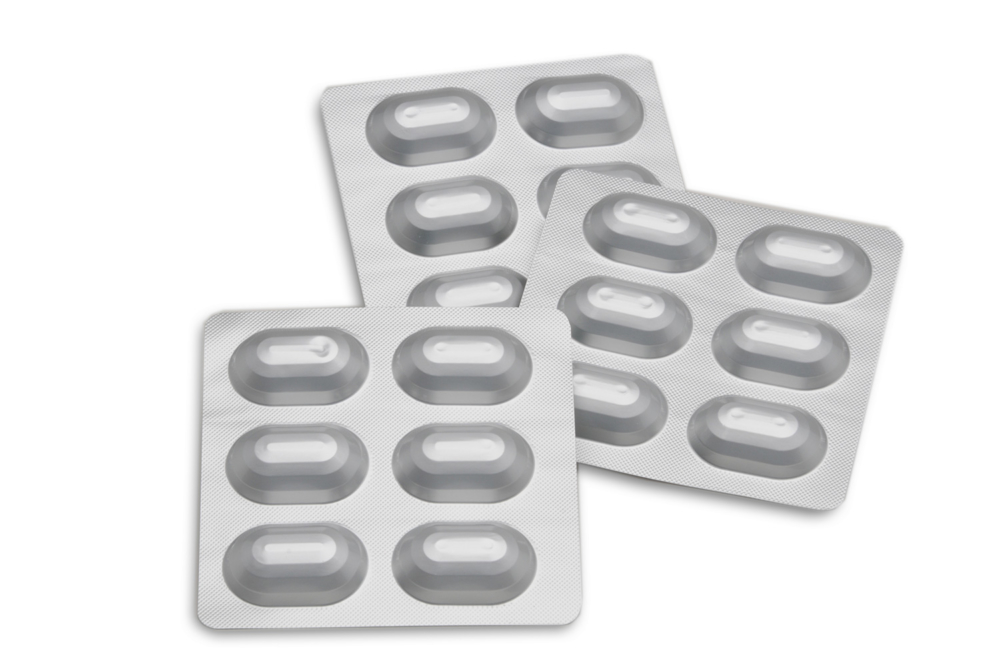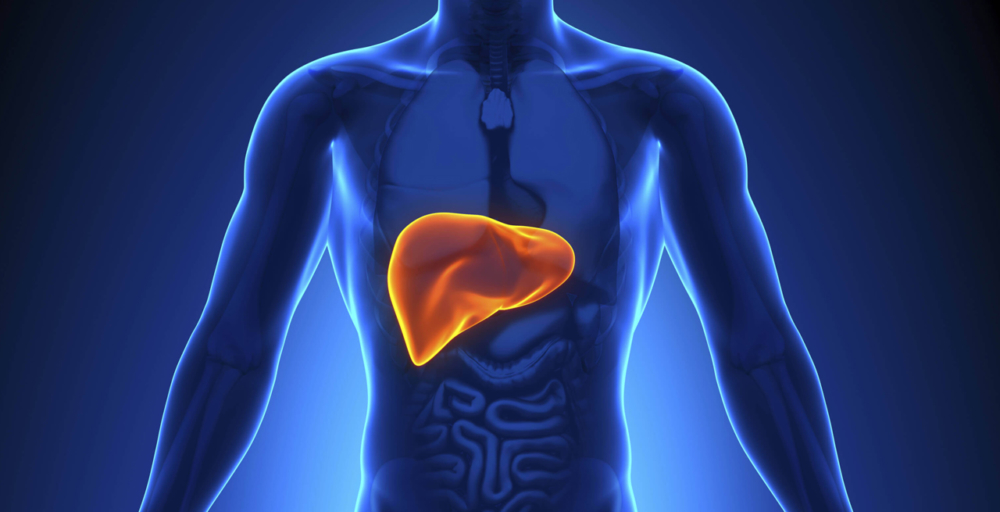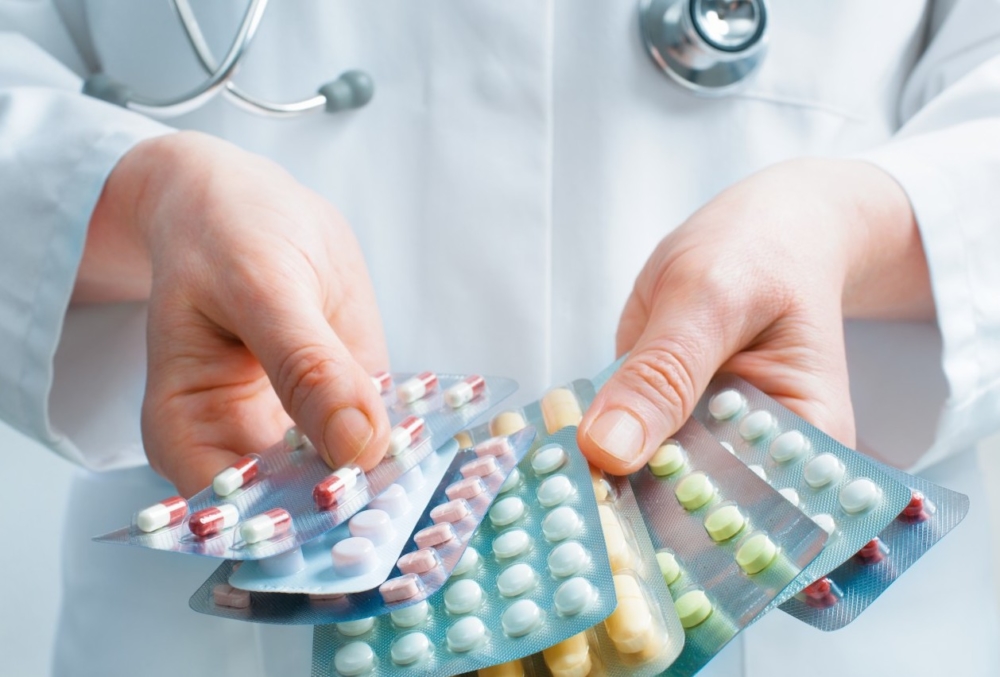No-Shpalgin in the instructions for use is described as a unique combined medication with high analgesic activity, designed to relieve pain of different localization, relieve spastic conditions of internal organs and reduce body temperature during fever. May be prescribed to children from 6 years.
Material Content:
- 1 Release forms and composition
- 2 Pharmacological action, pharmacodynamics and pharmacokinetics
- 3 In what cases is No-Shpalgin prescribed
- 4 Instructions for use and dosage
- 5 special instructions
- 6 During pregnancy and breastfeeding
- 7 Drug Interactions and Alcohol Compatibility
- 8 Contraindications, side effects and overdose
- 9 Analogues of the drug
Release forms and composition
The pharmacological product is available in the form of dark yellow elongated tablets with a groove for ease of separation. There are 12 pieces in a flat paper bundle, hermetically packed in a foil blister.
The active base of the medicine is represented by three healing components. Each tablet includes:
- paracetamol - a non-narcotic analgesic and antipyretic agent - 500 mg;
- effective natural opioid analgesic Codeine (as hemihydrate phosphate) - 8 mg;
- antispasmodic drotaverine (as hydrochloride) - 40 mg.
Additionally, inactive No-Shpalgin included inactive preservative and form-forming components.
Pharmacological action, pharmacodynamics and pharmacokinetics
The unique therapeutic effect of the drug is due to the combined effect of therapeutic substances in its composition:
- Paracetamol has a mild analgesic effect, inhibiting the formation of biological substances that irritate pain receptors. Its antipyretic effect is explained by the effect on the center of thermoregulation in the hypothalamus.
- Drotaverin, acting as an antispasmodic, relaxes the smooth muscle fibers of internal organs, prolongs the widening of the lumen of blood vessels, helping to lower blood pressure and increase the amount of blood passing through the heart structure per minute. Drotaverin enhances the action of Paracetamol, helping the body increase heat transfer due to vasodilation, which is especially important with the so-called white fever, when the fever does not subside due to vascular spasm.
- Codeine exhibits a strong analgesic effect, reducing the excitability of pain centers, and at the same time enhances the analgesic effect of Paracetamol. Possessing the properties of a muscle relaxant, deepens the effect of drotaverine on the relaxation of smooth muscle fibers of organs and vessel walls.
The pronounced antitussive property of codeine is usually not aggravated by respiratory depression if age-related dosages are observed when prescribing No-Shpalgin.
It should be noted that in combination, active substances show a more pronounced therapeutic efficacy than individually. Both Paracetamol and the well-known No-shpa pharmaceutical agent (which includes drotaverine) will have a weaker effect in case of severe pain than No-Shpalgin.
In this way, it is the combination of the three basic treating substances that provides a significant analgesic and antispasmodic effect with increased duration.
All three medicinal ingredients are actively absorbed from the digestive tract, evenly distributed throughout the body. They undergo enzymatic treatment in the liver with the formation of intermediate substances. Codeine breaks down into the active metabolites morphine and norkodein.
The maximum therapeutic effect of paracetamol against the background of its peak content in the blood appears after 30–80 minutes, codeine and drotaverine - 40-60 minutes. The time during which half of the dose that has entered the body is removed from the blood is approximately equal for all active components and ranges from 2 to 2.5–3.5 hours.
Intermediates in the metabolism of Paracetamol and Codeine are excreted in the urine. Approximately 85% of the amount of codeine and up to 95% of paracetamol in the blood is removed in 24 hours. As for drotaverine, it is completely eliminated from the body in 3 days.
All substances are found in the blood circulating between the placenta and the fetus, and in small quantities in breast milk.
Codeine is neutral to the pharmacokinetics of the other active constituents of No-Shpalgin. Paracetamol does not affect the processing in the liver and the removal of codeine from the blood, but it weakly inhibits the treatment of drotaverine with liver enzymes, which increases the duration of action of this active substance and up to 3–7 times its elimination from the blood.
In what cases is No-Shpalgin prescribed
The main indications for use, in which the pharmaceutical product is indicated, are prescribed in the medical instruction. These primarily include moderate and severe headache of various types of localization and origin, which occurs:
- in response to cerebrovascular spasm;
- due to tension of the occipital, frontal, temporal, cervical muscles under stress, long-term stored in an uncomfortable position of the head, neck, spine (pain of a tensile type);
- due to overwork, alcohol abuse.
The medication weakens even severe pain attacks, when other analgesics are ineffective.
However, experts confirm that No-Shpalgin helps with pain, which is caused by:
- convulsive contraction of the smooth muscles of the urinary tract with kidney stones, renal colic, urethrolithiasis, painful urination (tenesmus), cystitis and pyelitis;
- muscle spasm of the stomach, intestines, esophagus with enteritis, ulceration of the digestive organs, gastritis, pylorospasm, achalasia of the cardia, colitis;
- spastic contraction of the smooth muscles of the excretory ducts of the pancreas, gall bladder during their inflammation (cholangitis, pancreatitis), gallstone disease, hepatic and biliary colic, cholecystitis.
No-Shpalgin tablets will weaken pain during neuralgia and injuries, oncological processes, toothache, rheumatism.
In gynecological practice, the drug is prescribed for algodismenorrhea - severe pain during monthly bleeding.
Due to the presence of codeine, the drug blocks the cough reflex and reduces the number of attacks of frequent dry cough.
Instructions for use and dosage
The dosage and the optimal scheme for the use of the medication is determined by the attending physician, taking into account the patient's age, the severity of pain attacks, the type of pathology that provokes the pain syndrome.
No-Shpalgin tablets
In order to accelerate the analgesic, antipyretic effect, it is advisable to take pills either in the morning before breakfast, or in between meals, drinking plenty of boiled water.
The duration of taking No-Shpalgin without a doctor's prescription should not exceed 3 days. Codeine quickly causes psychophysiological dependence, therefore, further treatment should be discussed with the doctor so that he can monitor the results of therapy and, if necessary, adjust the treatment.
Patients over 12 years old usually prescribed once in a 1-2 tablet, but with severe pain, it is allowed to take a similar dose again after 8 hours. With a short course of therapy (2-3 days), no more than 6 tablets are allowed in 24 hours. If you have to use the medicine for a long time, then the dose is limited to 4 tablets per day.
No-Shpalgin for children 6-12 years of age are prescribed in reduced doses, reducing the frequency of use. For 1 time, a small patient can be given from half to a whole tablet. Secondary administration is allowed after 10-12 hours. The greatest number of pieces that a juvenile patient can receive in 24 hours is limited to 2 units.
With diseases of the liver and kidneys the dosage is set individually and adjusted downward, given the severity of organ dysfunction.
If the rate of glomerular filtration (GFR) is less than 30-15 ml / min, then the interval between doses should not be less than 12 hours. It is advisable to drink the medicine sporadically, rather than a course.
In ampoules for injections
In the injection solution, No-Shpalgin is not made, so there is no way to buy ampoules with the medicine.
special instructions
Since codeine is included in the pharmaceutical product, self-administration is limited to 3 days. If longer therapy is needed, medical supervision is required due to the risk of adverse reactions and the development of opiate addiction. It is necessary to control blood counts (AST, ALT, creatinine, white blood cells, platelets), the condition of the kidneys and liver.
If the medication is canceled after long-term therapy, there is a high probability of the appearance of signs of an antipsychotic syndrome (depression, overexcitation, insomnia).
Drotaverin reduces blood pressure due to vasodilation, which requires careful use in people with low blood pressure (hypotension).
If inhibition, dizziness is observed during therapy, the patient needs to refrain from activities where attention, accuracy, and reaction speed are needed (drivers of transport, surgeons, rescuers, pilots, machinists).
During pregnancy and breastfeeding
Admission No-Shpalgin during pregnancy and while breast-feeding a mother is permissible only for health reasons.
Animal studies have shown that codeine is able to inhibit the formation of bone tissue of the embryo, disrupt the heart rhythm of the fetus. The intake of this substance into the body shortly before childbirth often leads to a prolongation of the birth process.Once in mother’s milk, the medicine can depress the baby’s breathing, provoke developmental delay, and cause opiate addiction.
Drug Interactions and Alcohol Compatibility
During the course of therapy, alcohol is prohibited. Codeine deepens the harmful effects of ethanol on the nervous system. Possible respiratory failure, the appearance of convulsive reactions, trembling, overexcitation, a dangerous drop in pressure.
With the simultaneous use of No-Shpalgin with other medications, negative or positive effects may occur due to the pharmacological interaction of the active components.
Codeine will deepen the analgesic effect of any analgesic. But he
enhances the effect of sleeping pills, tranquilizers, sedatives, antipsychotics, ethanol, muscle relaxants, barbiturates (Phenobarbital), anesthetics for anesthesia.
When taking Sincumar, Warfarin, Phenilin, Warfarex (anticoagulants), the medication is allowed to be used only sporadically due to the risk of hemorrhage.
Ranitidine, cimetidine, famotidine slow down the metabolism of codeine and increase its manifestation.
Codeine inhibits the absorption of Mexitil, Ritalmex (Mexiletine), prevents the action of stimulants of intestinal peristalsis (Coordinax, Peristil, Cisapid, Cisapride), antiemetics (Cerucal, Metoclopramide), Motilium (domperidone).
If the patient takes medications for hypertension, then when interacting with drotaverine, this can cause a strong drop in blood pressure.
Drotaverin reduces the effectiveness of drugs such as Sindopa, Levodopa, Tidomet, Stalevo, Nakom, causing increased trembling of the fingers and muscle stiffness.
Paracetamol, which is part of the pharmaceutical product:
- with concomitant use with Adriblastin (doxorubicin) increases the likelihood of liver failure;
- lengthens the elimination time of chloramphenicol and enhances its toxic properties;
- reduces the effectiveness of Allopurinol, Azurix in patients with gout.
When combined with anticonvulsants, Rifampicin, Phenobarbital, antidepressants, Algamol, Salamide, Urtosal (salicylamides), ethanol, the concentration of toxic intermediate substances formed during the metabolism of paracetamol increases.
If treatment with drugs such as Fenelzin, Pargilin, Befol, Garmalin, and other MAO inhibitors, No-Shpalgin is allowed only 2 weeks after completion of therapy.
Contraindications, side effects and overdose
But-Shpalgin is not prescribed for pregnant and lactating patients, children under 6 years old, if they have been diagnosed with the following conditions:
- intolerance to any of the active and auxiliary components of the medication;
- severe kidney or liver failure;
- atrioventricular block 2–3 degrees, severe arrhythmia, previous stroke, heart attack;
- asthmatic status, bronchospasm, respiratory depression;
- collapse, epilepsy, glaucoma;
- increased intracranial pressure, severe hypotension;
- chronic alcohol and drug addiction, acute ethanol poisoning;
- recent brain injury;
- exacerbation of an ulcer of the digestive organs;
- any bleeding, decreased blood coagulability, hemophilia;
- glucose-6-phosphate dehydrogenase deficiency;
- the simultaneous use of other drugs containing opiates, drotaverine, paracetamol.
Caution is prescribed for Gilbert's syndrome, as well as for young patients 6-14 years old and for people over 65 due to the increased risk of respiratory depression.
With No-Shpalgin therapy, 1 out of 1000 patients (and less often) may display adverse reactions:
- headache and dizziness against a background of lowering blood pressure;
- nausea, drowsiness, lethargy, palpitations;
- decreased breathing, bronchospasm;
- nasal congestion due to swelling of the mucosa;
- constipation;
- in children - overexcitation, nightmares, muscle twitches;
- allergic reactions (itching, rash, hot flashes) up to critical manifestations (laryngeal edema, laryngospasm, anaphylactic shock);
- impaired hematopoiesis, increased blood flow (reduced platelet count, agranulocytosis);
With long-term use, addiction and dependence with the manifestation of “breaking” is possible 2-3 months after the intake of codeine in the body.
With prolonged use of the drug or the use of high doses, there is a risk of serious liver poisoning, up to a life-threatening toxic organ damage with tissue destruction (necrosis).
Signs of this condition are:
- pallor of the skin due to impaired blood flow, cold sweat;
- vomiting, loss of orientation, drop in blood pressure and body temperature;
- lethargy, irritability, rare palpitations, exhaustion;
- difficult breathing due to paralysis of the respiratory muscles, narrowing of the pupil;
- double vision, hallucinations;
- pancreatitis, acute renal failure;
- in severe cases - convulsions, hemorrhagic syndrome, loss of consciousness, respiratory arrest, coma.
It is recommended that the patient is constantly thrilled to remove toxins from the body, gastric lavage (within 2 hours after the phenomena of acute overdose), salt laxatives (in the absence of diarrhea), and diuretics.
In severe damage to the kidneys, liver, and nervous system, urgent hospitalization of the patient with intravenous administration of antidotes - Naloxone, Nalorfin, Naltrexone (for codeine), Methionine and Acetylcysteine (for paracetamol) is required. Forced diuresis, ventilation, oxygen inhalation can be performed.
Analogues of the drug
No synonyms of No-Shpalgin with a combination of all three treating substances have been developed.
There are combined painkiller and antispasmodic pharmaceutical products in tablets containing drotaverine, paracetamol, other non-hormonal anti-inflammatory components or antispasmodics, anti-allergic substances, caffeine. But all of them are less effective than No-Shpalgin, if they do not contain codeine.
Sedalgin Neo, Pentalgin plus, Solpadein, Pentalgin-N, Kaffetin, Pentalgin-ICN, Sedal-M, Quintalgin can be considered analogues of the medication, but only if codeine is not excluded from their composition. Today in the pharmacies of the Russian Federation it is difficult to purchase such funds.
Among other drugs with a pronounced analgesic effect, there are: an injection solution of No-shpa. Ketorolac or Ketanol, which do not have, however, an antispasmodic effect, as well as Lornoxicam (Xefocam) are even more effective for pain relief.


